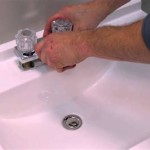Bathroom Sink Waste Pipe Height: Essential Aspects for Optimal Drainage
The height of the bathroom sink waste pipe is a crucial aspect that directly affects the efficiency of the drainage system. Proper positioning ensures smooth and swift water flow, preventing clogs, leaks, and unpleasant odors. Understanding the essential aspects of bathroom sink waste pipe height is paramount to achieve optimal drainage and maintain a functional bathroom. ### Pipe Diameter The diameter of the waste pipe determines the volume of water it can handle per unit time. A larger diameter allows for faster drainage, reducing the risk of water buildup and potential overflows. For bathroom sinks, a pipe diameter of 1.5 inches is generally recommended for optimal flow. ### Distance from Basin The distance between the bottom of the basin and the waste pipe influences the drainage rate. A greater distance creates a larger head of water, which exerts more pressure and increases the flow rate. Conversely, a shorter distance results in reduced pressure and slower drainage. Typically, a height of 20-30 cm from the basin bottom to the waste pipe is recommended. ### P-Trap Installation The P-trap is a U-shaped bend in the waste pipe that traps water, creating a seal that prevents sewer gases from entering the bathroom. The depth of the P-trap and its positioning beneath the drainage hole are crucial for proper drainage. A shallow P-trap or incorrect alignment can hinder water flow and create drainage issues. ### Slope of the Pipe The waste pipe should be installed with a slight downward slope toward the drain. This slope facilitates the flow of water and prevents water from pooling in the pipe, which can lead to clogs. The ideal slope is typically 1/4 inch per foot of pipe length. ### Pipe Material The material of the waste pipe also plays a role in drainage performance. PVC pipes are lightweight, durable, and resistant to corrosion, making them a common choice for bathroom sink waste pipes. Copper pipes are another option, offering excellent durability and corrosion resistance. ### Compliance with Codes When installing a bathroom sink waste pipe, it is essential to adhere to local building codes to ensure proper drainage and safety. Codes may specify minimum pipe diameters, slope requirements, and P-trap specifications. Compliance with codes helps prevent drainage problems and potential health hazards.
Standard Vanity Height With Vessel Bathroom Sink Drain Kitchen Countertop Faucets

How To Fit A Bathroom Sink Diy Guides Victorian Plumbing

How To Plumb A Bathroom With Multiple Plumbing Diagrams Hammerpedia

Rough In Plumbing Bathroom Dimensions Jim The Home Guy

How To Install A Pedestal Sink W Detailed Pictures Bestlife52

Connecting Soil And Waste Pipes To Below Ground Drainage

Gordee Bathroom Basin Sink Bottle P Trap Brass U Shape 1 4 Inch Slip Inlet Drain Lavatory Adjustable Height Waste Kit Pls Measure Ur Hole Size Before Order Matte Black

What Is The Bathroom Sink Drain Rough In Height Guide

What Is The Bathroom Sink Plumbing Rough In Heights

What Is The Standard Bathroom Sink Height Finest







